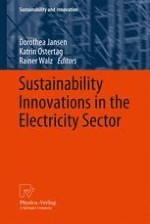2012 | OriginalPaper | Chapter
The Context of Innovation: How Established Actors Affect the Prospects of Bio-SNG Technology in Switzerland
Authors : Steffen Wirth, Jochen Markard
Published in: Sustainability Innovations in the Electricity Sector
Publisher: Physica-Verlag HD
Activate our intelligent search to find suitable subject content or patents.
Select sections of text to find matching patents with Artificial Intelligence. powered by
Select sections of text to find additional relevant content using AI-assisted search. powered by
